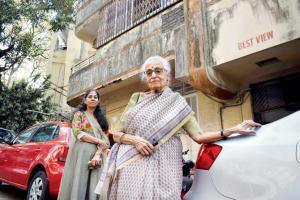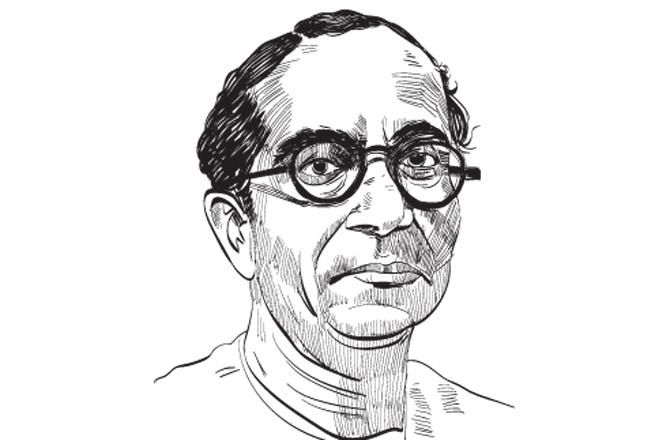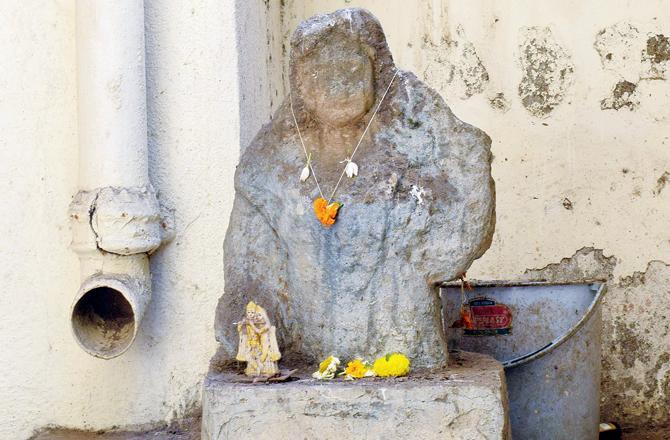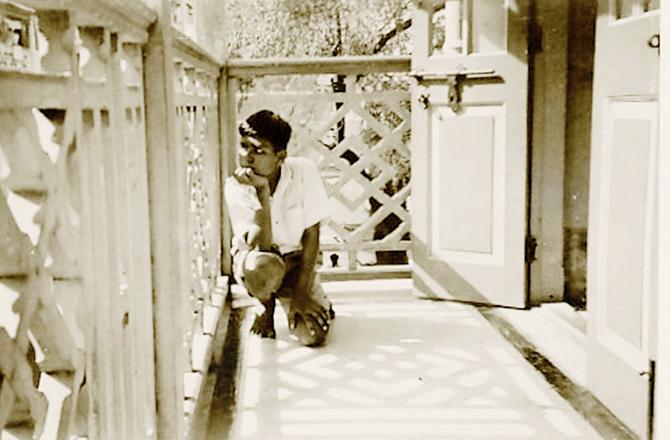On Raghavji Road, at Gowalia Tank, the politics of protest excited an unmatched culture of activism

Dr Mrudula Sampat with her neighbour Anjali Shah at the entrance of Best View, one of the addas of Indian National Theatre thanks to Bachu Sampat being a founder producer of the drama group. Pics/Ashish Raje
 Last week was the first time I walked Raghavji Road. To see the home of a half-forgotten hero, who framed the "Quit India" slogan and before that "Simon go back". Commonly attributed to Gandhiji, these catchphrases were originally coined by socialist Yusuf Meherally who, with the Mahatma's approval, distributed badges with "Quit India" printed on them. Rousing a whole country from this tiny lane off Gowalia Tank, that battle cry sparked the 1942 August Kranti revolt in the maidan opposite.
Last week was the first time I walked Raghavji Road. To see the home of a half-forgotten hero, who framed the "Quit India" slogan and before that "Simon go back". Commonly attributed to Gandhiji, these catchphrases were originally coined by socialist Yusuf Meherally who, with the Mahatma's approval, distributed badges with "Quit India" printed on them. Rousing a whole country from this tiny lane off Gowalia Tank, that battle cry sparked the 1942 August Kranti revolt in the maidan opposite.
Meherally's building, Bombay View, tail-ends Raghavji Road, his apartment lower than street level owing to the slant it perches on. I reach, taking in a bunch of "views" en route — Rock View, East View, Hill View and Best View being some three-storey residences rowed along the stretch. When they rose in the 1930s and '40s, they afforded fine sights of the rising sun, of a city panorama, of Forjett Hill. Though these still handsome structures stand largely intact, a haphazard rash of hideous towers engulfs Gowalia Tank, blocking the vantage views.
ADVERTISEMENT

Soli Mistry and his nephew Neville, co-owners of Hill View, halfway up Raghavji Road, at the gate of what is easily the lane’s best maintained building. Pic/Bipin Kokate
Who was Raghavji? I pose the query hopefully to everyone, starting with Dalsukh Darji of Ambika Tailors. No ordinary outfitter, this one's an usher too. A fixture so entrenched, he veritably heralds this slope, leading you into the lane. Anyone giving directions to Raghavji Road points out, "Turn at New Gentleman Restaurant, you can't miss the old tailors next to it."
Following their ancestral trade, Dalsukh and his brothers, uncles and nephews came in 1969 to Botawala Building which frontlines the cul de sac. "Without sewing machines, our grandfather hand-stitched garments. Dada's clothes were basic but best in our Gujarat village, Khodamba. News of us spread fast once we were here. Any lady on Pedder Road-Warden Road-Nepean Sea Road will praise our perfect sari choli fit."

Yusuf Meherally, living on Raghavji Road, galvanised nationalist politics in the 1930s and '40s. Illustration/Uday Mohite
Across his shop, even residents of century-old Raghavji Building appear foggy about Raghavji's identity. He was a Kutchi sethia from Walkeshwar with estates in this area, offers Shantikumar Merchant. The 81-year-old recalls Raghavji Building, Botawala Building, Bombay View and Rele Chambers were the earliest structures. "Our ceilings are 26 feet high, walls 27 inches wide," declares Merchant. He misses the bora tree (felled to construct Asha building) outside his verandah.
In the 1960s, the wilderness cleared for Asha threw up an intriguing stone sculpture. Although no goddess, the excavated figure is deified by dhobis at the spot, who wash and garland it. A gentle climb north, gulmohars sigh delicately at Art Deco-trimmed windows of Best View and Bombay View.

The stone figure excavated by workers clearing thickets to con-struct Asha building in the '60s
After its heyday as the Meherally-presided adda at which patriots hatched plots to go underground, notoriety dogged Bombay View. A brothel thrived there till 20 years ago. The middle-class tranquillity rooting the road was rocked as colourful couples noisily flashed past in cabs to either the bordello or an illicit brewery facing it. In a quite unusual display of neighbourhood strength, residents initiated a simple, if questionable, system effective enough to forever foil the operation.
Casually stationed a few feet from each other, the locality's young men with a handful of women patrolled in shifts till 2 am. They whoop-whistled alerts on spying suspect taxis that ferried customers. "Our gully boys pulled them out of their taxis and, helped by Inspector Shankar Shetty from Vinod building, stripped off their clothes," says tuition teacher Nazli Currimbhoy. One man making this his stop between Delhi and Dubai got his onward ticket torn by the vigilantes. "We know your relatives, we'll report this to your wife," they bluffed to recognisably regular clients. Doing whatever it took, they managed to bust the business.

At 81, Shantidas Merchant considers himself the oldest resident on Raghavji Road since birth
Among those defenders was Rajathh, actress Swaroop Sampat's brother, from Best View, beside the infamous Bombay View. Their thespian father Bachu Sampat was a founder producer of the Indian National Theatre (INT). His wife, Dr Mrudula Sampat, consultant histopathologist at Tata Memorial Hospital, says, "We moved in 60 years ago because the peace and greenery made us feel we were on holiday out of town."
A door away is Dr Malvika Chari, retired medical practitioner who established the Avehi Trust. Born to jurist eminence — her father Mangaldas Mehta was partner at Amarchand Mangaldas — she married Lalit Chari, acknowledged as a brilliant lawyer by the many he mentored. Belonging to the card-carrying cadre of the Communist Party of India, Lalit's parents, ace criminal lawyer ASR and Dilshad Chari, were highly regarded in an age that did not equate communism with anti-nationalism. Raised in party-run communes, they matched the moral integrity and intellectual rigour of INT luminaries staging their theatre of protest.

Shantidas as a boy on the verandah of Raghavji Building before it was renovated
Between clans like the Charis and the Sampats, the street's political culture continued to creatively feed from the template Yusuf Meherally set. "Be it Yusuf Bhai's socialism or the Charis' communism, their fervour succeeded in raising public consciousness sharply," says Dr GG Parikh. A legend on nearby Sleater Road, the nonagenarian manages the Yusuf Meherally Study Centre and co-edits Janata, the Praja Socialist Party magazine, from 1946.
"Supporting neither revolution nor dictatorship, the socialists equally wanted justice for the have-nots. Yusuf Bhai dropped his privileged surname of Merchant. His room at Bombay View was where inspired students gathered like magnets. Beaten for demonstrating against the British, he was rolled in a barrel from the top of Grant Road Bridge."
The city's youngest mayor in 1942, Meherally passed on at the age of 47. Shocked at the premature loss of its charismatic leader, Bombay ground to a halt the day after his demise in July 1950. Schools, colleges and mills shut, the Stock Exchange witnessed no trading. At the stroke of noon, buses, trams and trains stopped for reflective minutes.
Padding around I find Hill View, with Victorian-invites-vernacular embellishments, easiest on the eye. Among the co-owners, Soli Mistry's father Rustomji, a dye importer and then manufacturer, acquired the property some years after its erection in 1938. "We are strict landlords," Mistry says. "Grills and ACs on the facade are firmly banned." Signing rent receipts ad nauseam allows him to accurately reel off tenants' names, including the music loving Rajadhyakshas and Ratanjankars.
"We enjoy a building in immaculate condition since 1938," says Shailesh Rajadhyaksha in the flat his family has occupied over 80 years. Exactly below, Morarji Desai's grandson Bharat lives in what was the Ratanjankar brothers' home. Among them was Padma Bhushan recipient, Hindustani classical singer SN Ratanjankar. Lauded for renditions of the dhrupad and khayal styles of the Agra gharana, he was Chairman of the Jury of Auditions for All India Radio.
For almost four decades now, the Rajadhyakshas celebrate Ganpati inviting musicians like Raja Miyan (son of Anwar Hussain Khan of Ruby Mansion from step-away Forjett Street, the hallowed home of prodigious generations of Agra gharana singers) to display their virtuosity. "Raja Miyan's uncle, Khadim Hussain Khan visited this apartment to tutor my uncle, Krishnakant 'Nana' Rajadhyaksha", says Shailesh. I'm led to an inner room where his father, harmonium exponent and amateur sarangi player Harishchandra 'Bhau' Rajadhyaksha, practised. Their vocalist cousin Padmaja Punde was a distinguished presence at these mehfils. As was another relative, tabla maestro Bhai Gaitonde, who used to accompany them before enthralling the audience with a solo performance.
The Rajadhyakshas direct me to a personality I consider the star of Raghavji Road: 85-year-old Armaity Desai in Rele Chambers. Her mother Tehmina was an academician of repute and father Shapur a renowned secretary of the Parsi Panchayet. Dr Desai served on the founding team of the College of Social Work, Nirmala Niketan, going on to be Director of the Tata Institute of Social Sciences and finally Chairperson of the University Grants Commission.
"What my pucca firebrand nationalist parents wore to their wedding shocked both their families," she laughs. "Father dressed in the dagli and trousers, but in khadi material. Mum refused to drape the embroidered gaara, declaring it a foreign import. She chose a Surat ganth sari instead." Desai's grand-uncle, Zoroastrian scholar-priest Sir Jivanji Jamshedji Modi, was to marry them. Loyal to the Brits knighting him, he was initially horrified by the couple's sartorial choices, yet relented and conducted the ceremony.
"With Dilshad Chari, my mother urged people to flutter khadi flags from poles tied to their balconies," says Desai. "Together, they formed the Raghavji Road Mahila Mandal, organising craft sessions, and Hindi and Urdu classes (as a branch of the Hindustani Prachar Sabha) from my home." Nazli Currimbhoy adds how her mother Malek and other women distributed free milk on Sunday mornings in a charity activity the group volunteered.
In other homes, wizened denizens like Villoo and her brother Bomi Plumber, recollect robust rounds of cricket on the road. Noticing my look of but-every-gully-loves-this-game, Villoo quickly says, "And we balanced on bamboos laid crisscross on the road when it had little traffic — very difficult to do, you must understand." Socialists, communists, educators, entertainers, activists, artistes, history makers, history sheeters… this alley has had them all. The signboard that announces "Raghavji Road" leaves me wondering. Ironic how a pathway to commemorate a shadowy landowner got such a shot at becoming proletarian paradise.
Author-publisher Meher Marfatia writes fortnightly on everything that makes her love Mumbai and adore Bombay. You can reach her at mehermarfatia@gmail.com/
www.mehermarfatia.com
Catch up on all the latest Crime, National, International and Hatke news here. Also download the new mid-day Android and iOS apps to get latest updates
 Subscribe today by clicking the link and stay updated with the latest news!" Click here!
Subscribe today by clicking the link and stay updated with the latest news!" Click here!







